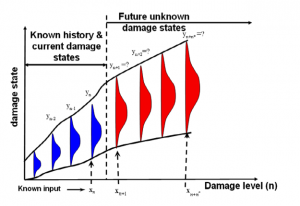From the space shuttle to passenger aircraft, prognosis via state-awareness and life models are becoming increasingly important. Once the current state of the system has been diagnosed, prognosis is used to contribute to the sustainment of structural reliability, survivability and mission readiness, especially in extreme environmental conditions.
The prognosis system uses a hybrid, physics-based and data- driven model supplemented by sensor information to assess the health of individual structural systems as they are subjected to stresses that cause fatigue, fracture, and corrosion during normal operational and extreme environmental use. The physics-based model is based on a multi-scale micro/meso/macro-finite element model. The data-driven model is based on a data-driven Gaussian process approach. This method correlates the individual input parameters affecting the fatigue crack growth while the output crack growth is correlated using a Markovian stochastic approach. This hybrid prognosis model is also augmented with dynamic load information available from system identification and reduced order modeling.
